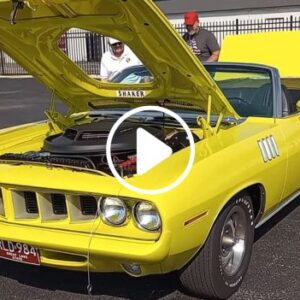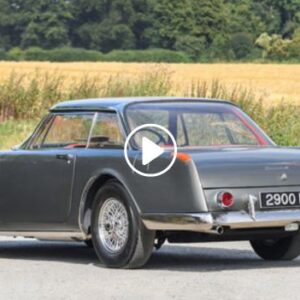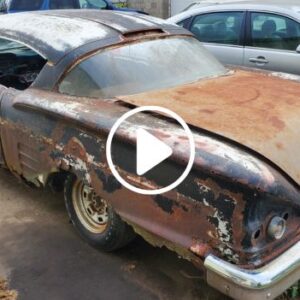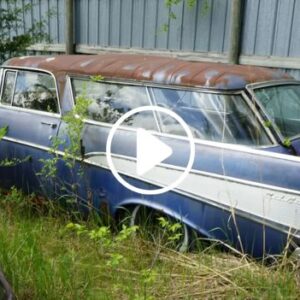Automotive YouTuber Chris of 3:23 Fabrication explored his friend’s recently acquired 1969 Chevrolet Nova that’s in rough shape. The video is the first of presumably a series of videos that will document the vehicle’s return to its former glory.
On the outside, it looks like any other 1968 or 1969 Chevy Nova that is in bad condition as both model years shared the same exterior styling. But the special order vehicle had a few surprises in the interior including a floor-mounted shifter for its Powerglide automatic transmission, a radio delete panel, and special order front bucket seats that replaced the Nova’s standard front bench seats.
Chris and his friend Joey didn’t complete the restoration work in this initial video. But they plans to make the Nova drivable again, repair some bodywork damage, and add a few additional features in a later update video.
The Rare Custom 1969 Chevy Nova Is A Unique Vehicle
The special order 1969 Chevy Nova was clearly in bad condition at the start of the video when Chris first revealed it together with his friend, Joey. The 6-cylinder automatic transmission Nova had a few holes in the hood and the trunk, the original black paint was slightly faded and there were a few rust spots around the body.
Opening the hood revealed the vehicle’s inline-6 engine. The motor was in rough shape with plenty of dirt after years of driving and recent sandblasting work. But interestingly, the engine had new oil in it. Chris did share that they intend to restore the engine to working order.
Despite being in bad condition, the YouTuber commented that the parts that would have been difficult to repair are in relatively decent condition with most damage being relatively isolated to easily fixable parts. Nova’s, after all, have the reputation for being cheap to restore.
Chris also shared that it is a 10-bolt car, a term that describes a General Motors vehicle’s differential which is popular among muscle car enthusiasts because of a 10-bolt’s ease of modification, availability, and affordability.
Chris and Joey started off the restoration work in the video by power washing the car, the result of which brought back most of the shine of its original paint job. As they pressure washed the car, they discovered a bee hive in the front fender, which luckily didn’t have any bees anymore.
While they didn’t get to start the engine in this video, they worked to reinstall the front and rear seats and the vehicle’s shiny dog dish hub caps that complete the Nova’s exterior look.
In the video’s description, the YouTuber wrote that they had already found a replacement hood and trunk and that they had plans to build the Powerglide transmission and install AC into the car in a future update video.
What Engine Is In A 1969 Chevy Nova?
In the 1969 model year, the relatively affordable Chevy Nova had six engine choices — one inline-4, two inline-6, and three V8 options.
Engine Specs
| Engine | Super-Thrift 153 | Turbo-Thrift 230 | Turbo-Thrift 250 | Turbo-Fire 307 | Turbo-Fire 350 | Turbo-Fire 350 (2-door coupe) |
| Configuration | Inline-4 | Inline-6 | Inline-6 | V8 | V8 | V8 |
| Displacement | 2.5 liters (153 cu. in.) | 3.7 liters (230 cu. in.) | 4.0 liters (250 cu. in.) | 5.0 liters (307 cu. in.) | 5.7 liters (350 cu. in.) | 5.7 liters (350 cu. in.) |
| Power | 90 hp | 140 hp | 155 hp | 200 hp | 255 hp | 300 hp |
| Torque | 152 lb-ft. | 220 lb-ft. | 235 lb-ft. | 300 lb-ft. | 365 lb-ft. | 380 lb-ft. |
The sole inline-4 was the smallest of the six engine choices with the Nova. It is the 2.5-liter 4-cylinder Super-Thrift 153 engine that produced 90 hp and 152 lb-ft of torque.
The two inline-6 options of the 1969 Nova were the Turbo-Thrift 230 and the Turbo-Thrift 250. The 3.7-liter 6-cylinder Turbo-Thrift 230 produced 140 hp and 220 lb-ft. of torque. The larger 4.0-liter Turbo-Thrift 250 slightly increased that power output to 155 hp and 235 lb-ft of torque.
The Nova in the video had one of these two inline-six engines, although it wasn’t clear which. However, that won’t matter for much longer as the owner plans to perform an LS swap on the vehicle — the practice of replacing a vehicle’s stock engine with General Motors’s popular, lightweight, and compact LS V8 engines.
Chris said he would share an update in a later video.
The most powerful of the engine choices were the three large V8 motors — the Turbo-Fire 307, and two Turbo-Fire 350 that had subtle differences between them.
The 5.0-liter V8 Turbo-Fire 307 produced 200 hp and 300 lb-ft of torque. Unlike the 4-cylinder and 6-cylinder options, the Turbo-Fire 307 had a two-barrel carburetor.
The two 5.7-liter V8 Turbo-Fire 350 engine options had minor differences, although one was significantly more powerful than the other. One Turbo-Fire 350 produced 255 hp and 365 lb-ft of torque while the more powerful one produced 300 hp and 380 lb-ft of torque. Chevy only offered the more powerful Turbo-Fire 350s with four-barrel carburetors on the two-door novas.
Is The Nova A Muscle Car?
The 1969 Chevy Nova straddles a fine line between being a pony car and a muscle car.
Muscle cars are powerful 2-door American-made sports cars that typically have a V8 engine and boxy looks. Pony cars, on the other hand, are incredibly similar to muscle cars with only minor differences. They usually have the same exterior styling as muscle cars and American roots but have a weaker V8 or inline-6 engine.
The majority of 1969 Chevy Novas had either an inline-4 or inline-6 engine — with over 157,000 having the inline-6 engine and over 5,000 having the inline-4 option according to data listed on Nova Resource. These metrics make the Nova seem to fit the pony car classification more than the muscle car classification.
Furthermore, nearly 70,000 examples of the 1969 Chevy Novas were 4-door sedans that definitely didn’t fit the mold of a muscle car.
However, many still argue that the 1969 Nova is definitely a muscle car because of its long hood, rear-wheel drive layout, boxy exterior, 2-door coupe body style option, especially the V8-powered ones. Over 182,000 examples were of the 2-door coupe body style among which over 88,000 Novas built had a V8 engine — making the Nova a true muscle car.
What Is The Most Desirable Chevy Nova?
The most desirable 1969 Chevy Nova was quite possibly the top-of-the-line Nova SS, which is a car that every gearhead should consider buying. Of the 268,000 Novas that Chevrolet produced in 1969, only around 17,000 were the high-performance Nova SS.
The Nova SS had the most powerful engine option, the Turbo-Fire 350 V8, and a host of other performance upgrades including stronger main-bearing bulkheads, a special three-speed manual gearbox with a floor shifter, stiffer front coil springs, and single disc power front brakes — a first for any Nova SS at the time.
Some 1969 Nova SS examples even had more powerful engines than the 300-hp 5.7-liter Turbo-Fire 350 V8. Around 5,000 examples of the 1969 Nova SS vehicles came out of the factory with the larger and more powerful 6.5-liter Turbo-Jet 396 V8 that produced 375 hp while around 2,000 came with a slightly less powerful version of the same engine that produced 350 hp.
The 1969 model year was one year before Chevy stopped offering a Nova SS with a big-block V8, making Nova SS 396s even more desirable.
Beyond performance enhancements, Chevy incorporated numerous SS-exclusive design elements to make the car stand out against the regular Nova.
On the exterior, these included a black accented front grille with an SS emblem, simulated hood air intakes, iconic red striped tires, simulated front fender louvers, engine emblems on the front fenders, and a concealed fuel filler. Some SS-exclusive exterior options included accent striping, bright side window moldings, lower body and rear fender moldings, and a black lower body accent band.
In the interior, enhancements included standard front bucket seats, front door armrests, and a cigarette lighter. Optional packages take it up a notch with additional creature comforts like automatic interior lights, pattern cloth and vinyl interior, extra-thick foam-cushioned front seats, rear armrests, and special body and hood insulation.








